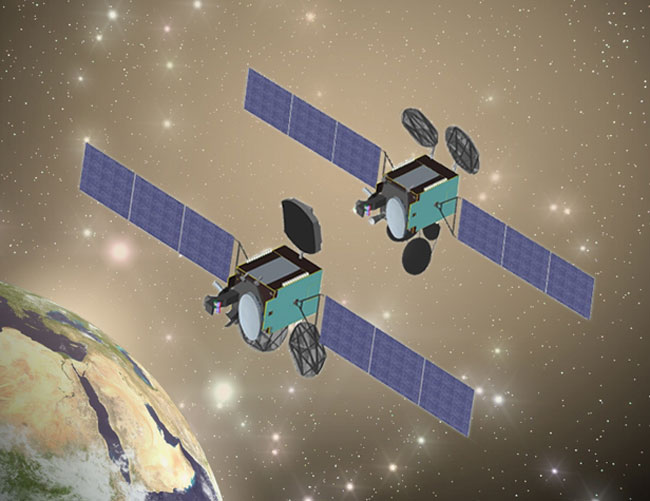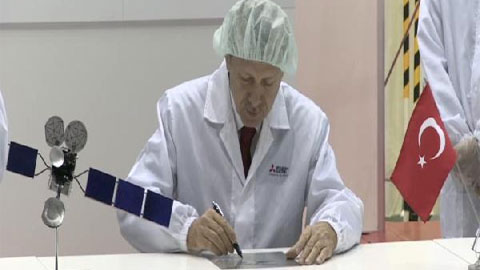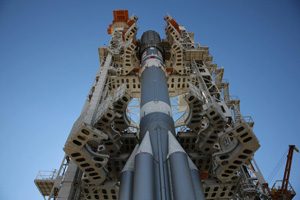
With less than a month to go until its first mission of 2014, International Launch Services (ILS)—the joint U.S.-Russian company which operates all commercial Proton-M rockets out of Baikonur Cosmodrome, Kazakhstan—has secured two key contracts to loft major payloads into orbit next year. Yesterday (Tuesday), ILS announced that it will launch the high-powered Intelsat DLA-2 communications satellite, and today (Wednesday) it reported it will also deliver Eutelsat 9B into orbit. Both missions are anticipated to take place in 2015. The Reston, Va.-based ILS is currently targeting 10 February for its next Proton-M mission to insert Turkey’s Türksat 4A communications satellite into geostationary transfer orbit.
According to ILS, next year’s flight of Intelsat DLA-2 will utilize the Phase IV performance capability of the Proton-M, with an enhanced Briz-M upper stage. The satellite is currently under construction by Space Systems/Loral (SS/L) in Palo Alto, Calif., and its Ku-band payloads are expected to expand Direct-to-Home entertainment and provide backup and restoration services across Latin America. The satellite also carries 10 C-band transponders for Intelsat’s own business-expansion efforts in the growing Latin American markets. Both it and Intelsat DLA-1, which will fly aboard Europe’s Ariane 5 vehicle later this year, are to be co-located with Intelsat’s Galaxy 3C satellite at 95 degrees West longitude. Also heading for a 2015 Proton-M launch is Eutelsat 9B, whose 66 Ku-band transponders will deliver fresh resources and enhanced performance for broadcasting, via multiple service areas over Europe. To be located at 9 degrees East longitude, it will also host a laser communications terminal and Ka-band inter-satellite link, which marks the first data-relay payload for the planned European Data Relay Satellite System (EDRS).
ILS, formed back in 1995, supported its first commercial launch of a Proton in April 1996 and boasts an impressive success record with the booster. With February’s planned mission to insert Türksat 4A into geostationary transfer orbit, it will be the 85th ILS Proton to fly, but marks the first time that the Türksat Satellite Communications and Cable TV Operations Company—headquartered in Turkey’s central Ankara Province—has contracted one of its satellites to ILS. The 8,380-pound (3,800-kg) satellite is based upon the Spacebus MELCO DS2000, built by Mitsubishi Electric (MELCO) at its Kamakura plant in Tokyo. The satellite utilizes the Ku-, Ka-, and C-bands. After launch from Baikonur, Türksat 4A will be placed into a geostationary orbit, approximately 22,300 miles (35,000 km) high, at 42 degrees East longitude, providing communications services and direct television broadcasts across a broad region, from Central Asia, across the Middle East and Africa and Europe, and as far as eastern England. The satellite will provide a high flexibility of switchability and connectivity among different service areas to its customers.
The contracts between ILS and MELCO to launch Türksat 4A and 4B were signed in April 2011, with plans to place the former satellite into orbit at 42 degrees East longitude and the latter at 50 degrees East. Speaking at the time, Hiroyuki Inahata, head of MELCO’s space systems division, remarked that the choice of ILS as launch services provider was made “based on their track record of reliability, precision, launch tempo and experience.”

With Türksat 4B also expected to fly aboard an ILS Proton later this year, efforts are already entering high gear to prepare Turkey’s communications birds for their missions. Last week, during an official visit to Japan by Turkish Prime Minister Recep Tayyip Erdoğan, the Türksat 4A payload was formally handed over by Mitsubishi Electric to Turkish officials. According to ILS, the main team for the mission arrived in Baikonur on Monday, 13 January, ahead of the scheduled arrival of Türksat 4A aboard an Antonov carrier aircraft tomorrow (Thursday, 16 January). “It was a wintry landing,” admitted ILS in the first entry of its Türksat 4A mission blog, “but all personnel and their luggage along with equipment landed safely.” It was also noted that both the Proton-M and its Briz-M upper stage, which will deliver the satellite into orbit, are presently “in various processing halls undergoing tests in preparation for the launch.”
Although the actual flight is three weeks away, the final preparations will begin a day or so ahead of liftoff, with the rollout of the three-stage Proton-M and its Briz-M upper stage to the Site 24 complex at Baikonur. Built by Russia’s Khrunichev Research and State Production Centre, this will be the 393rd mission by a member of the Proton rocket family, which traces its heritage back to the mid-1960s and has one of the most reliable track records of any rocket in the world. However, last year proved troubled when it suffered a dramatic and highly embarrassing launch failure on 2 July, seconds after liftoff. It was the Proton’s first catastrophic malfunction during first-stage flight in over 30 years and prompted several months of corrective actions and cutting managerial and organizational changes. A few weeks later, the Proton returned triumphantly to flight on 29 September, delivering the Astra 2E communications satellite into orbit, and restored its reliability credentials on 25/26 October by launching Sirius FM-6 and on 12 November by launching Raduga-1M-3. Finally, on 8 December, it flawlessly delivered the Inmarsat 5-F1 payload into orbit.
On launch morning, fueling of the Proton’s three stages with a mixture of nitrogen tetroxide and unsymmetrical dimethyl hydrazine will commence about nine hours before the planned liftoff. The first stage consists of a central oxidizer tank, surrounded by six outboard fuel tanks, each fed by an RD-276 engine, and these will provide the initial impetus to boost Türksat 4A toward space. At T-5 minutes, the Briz-M upper stage will be transferred to internal power and will confirm the health of its systems. Ignition of the six RD-276 engines will commence at T-2 seconds, ramping up to 100 percent of rated performance to produce 2.3 million pounds (1.04 million kg) of thrust at the moment of liftoff.

A little over a minute into the ascent, the Proton will encounter a period of maximum aerodynamic stress (known as “Max Q”) on its flight surfaces, and the separation of the first stage is timed to occur at the two-minute point. The vehicle’s second stage will then pick up the baton, with its four engines generating a combined 540,000 pounds (244,950 kg) of propulsive yield for a little over 3.5 minutes. Soon after second-stage separation, the Payload Fairing (PLF) will be jettisoned and the single-engine third stage will add a further 138,000 pounds (62,600 kg) of thrust for the next four minutes of flight. Shutdown of the third stage should occur about 10 minutes after launch, by which time the vehicle will have been establish onto a suborbital trajectory.
After a 90-second period of coasting, the turn will come for the Briz-M, which has exhibited a mixture of success and failure since its maiden voyage. In August 2012, a premature shutdown of the Briz-M left Indonesia’s Telkom-3 and Russia’s Ekspress-MD2 satellites in useless orbits, and in December 2012 another launch glitch impacted the Yamal-402 satellite. Last March, a Proton-M/Briz-M successfully injected Mexico’s Satmex-8 communications satellite into orbit, and on 29 September another vehicle lofted Astra 2E. Capable of restarting up to eight times in flight, the Briz-M has a battery-powered lifetime of 24 hours and is scheduled to execute five “burns” to insert Türksat 4A into orbit. Assuming an on-time liftoff, the payload should be injected directly into its geostationary orbit about nine hours and 13 minutes into the mission and should communicate with ground stations shortly thereafter.
Want to keep up-to-date with all things space? Be sure to “Like” AmericaSpace on Facebook and follow us on Twitter: @AmericaSpace



